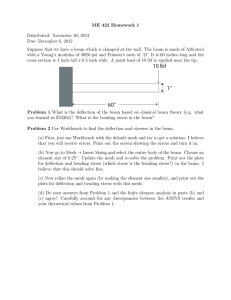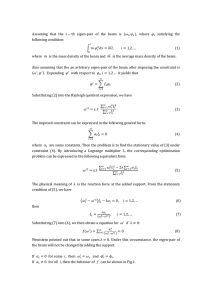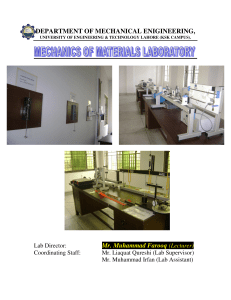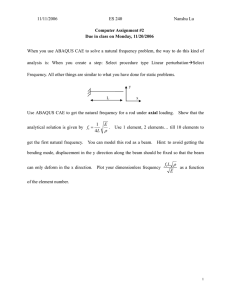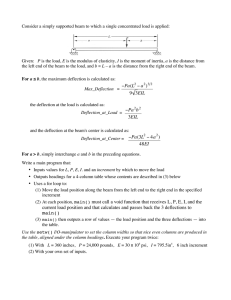Lecture 8: Energy Methods in Elasticity
advertisement
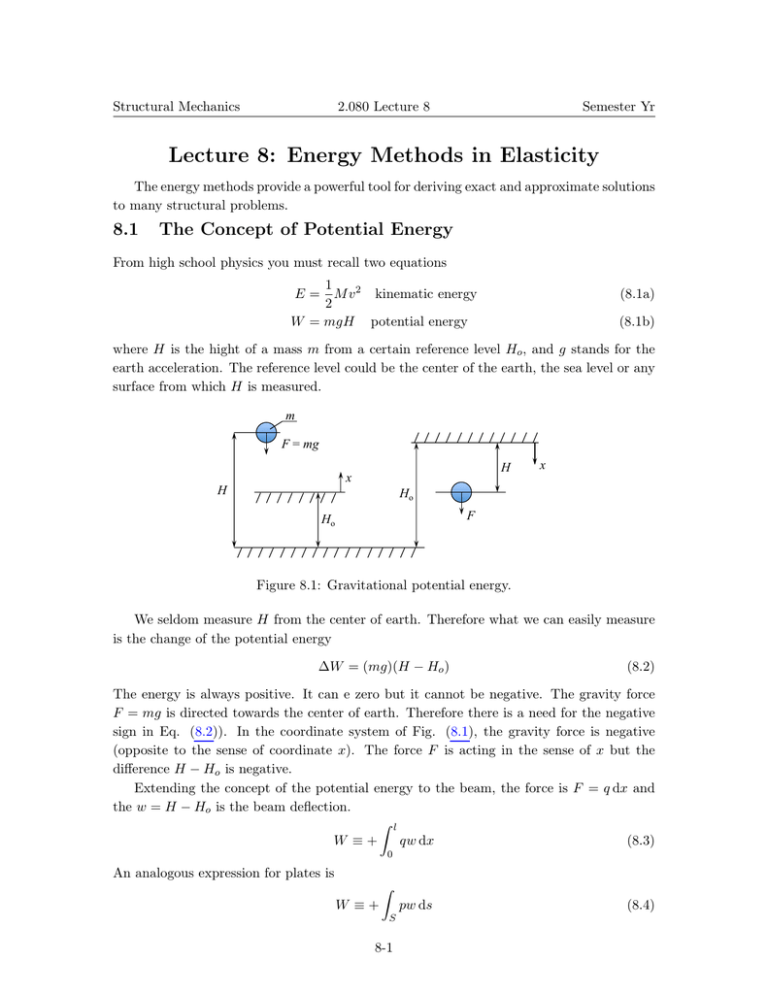
Structural Mechanics 2.080 Lecture 8 Semester Yr Lecture 8: Energy Methods in Elasticity The energy methods provide a powerful tool for deriving exact and approximate solutions to many structural problems. 8.1 The Concept of Potential Energy From high school physics you must recall two equations 1 E = M v 2 kinematic energy 2 W = mgH potential energy (8.1a) (8.1b) where H is the hight of a mass m from a certain reference level Ho , and g stands for the earth acceleration. The reference level could be the center of the earth, the sea level or any surface from which H is measured. m F = mg H x H x Ho F Ho Figure 8.1: Gravitational potential energy. We seldom measure H from the center of earth. Therefore what we can easily measure is the change of the potential energy ∆W = (mg)(H − Ho ) (8.2) The energy is always positive. It can e zero but it cannot be negative. The gravity force F = mg is directed towards the center of earth. Therefore there is a need for the negative sign in Eq. (8.2)). In the coordinate system of Fig. (8.1), the gravity force is negative (opposite to the sense of coordinate x). The force F is acting in the sense of x but the difference H − Ho is negative. Extending the concept of the potential energy to the beam, the force is F = q dx and the w = H − Ho is the beam deflection. Z l W ≡+ qw dx (8.3) 0 An analogous expression for plates is W ≡+ Z pw ds S 8-1 (8.4) Structural Mechanics 2.080 Lecture 8 Semester Yr q q(x) x z dx w w H z Ho Figure 8.2: Potential energy of a beam element and the entire beam. In the above definition W is negative. The concept of the energy stored elastically U has been introduced earlier. For a 3-D body Z 1 σij ij dv (8.5) U= V 2 and for a beam Z l Z l 1 1 ◦ U= M K dx + N dx (8.6) 0 2 0 2 For plates, the bending and membrane energies are given by Eqs. (4.73), (4.74) and (4.86), (4.87). The total potential energy Π is a new concept, and it is defined as the sum of the drain energy and potential energy Π = U + (−W ) = U − W (8.7) Consider for a while that the material is rigid, for which U ≡ 0. Imagine a rigid ball being displaced by an infinitesimal amount on a flat (θ = 0) and inclined (θ 6= 0) surface, Fig. (8.3). θ δu x x H δu δH Figure 8.3: Test if an infinitesimal displacement δu causes the potential energy to change. We have H = u sin θ and δH = δu sin θ. The total potential energy and its change is Π = −W = −F u sin θ δΠ = −δW = −(F sin θ)δu (8.8a) (8.8b) On the flat surface, θ = 0 and δΠ = 0, and the ball is in static (neutral) equilibrium. If θ > 0, δΠ 6= 0 and the ball is not in static equilibrium. Note that if the d’Alambert inertia 8-2 Structural Mechanics 2.080 Lecture 8 Semester Yr force in the direction of motion is added, the ball will still be in dynamic equilibrium. In this lecture, only static equilibrium is considered. We can now extend the above test for equilibrium and introduce the following principle: The system is said to be in equilibrium, if an infinitesimal change of the argument a of the total potential energy Π = Π(a) does not change the total potential energy δΠ(a) = ∂Π δa = 0 ∂a (8.9) Because δa 6= 0 (δa = 0 is a trivial case in which no test for equilibrium is performed), the necessary and sufficient condition for stability is ∂Π =0 ∂a (8.10) In case when the functional Π is a function of many (say N ) variables Π = Π(ai ), the increment ∂Π δΠ = δai , i = 1, ..., N (8.11) ∂ai The system is in equilibrium if the derivative of Π with respect to each variable at a time vanishes ∂Π(ai ) = 0, i = 1, ..., N (8.12) ∂ai The meaning of the argument(s) ai , or independent variables will be explained next. 8.2 Equivalence of the Minimum Potential Energy and Principle of Virtual Work The concept of virtual displacement δui is the backbone of the energy methods in mechanics. The virtual displacement is a small hypothetical displacement which satisfy the kinematic boundary condition. The virtual strains δij are obtained from the virtual displacement by The increment of stress δσij elasticity law 1 δij = (δui,j + δuj,i ) (8.13) 2 corresponding to the increment of strain is obtained from the σij = Cijkl kl (8.14a) δσij = Cijkl δkl (8.14b) σij δij = ij δσij (8.15) Therefore, by eliminating Cijkl The total strain energy of the elastic system Π is the sum of the elastic strain energy stored and the work of external forces Z Z 1 Π= σij ij dv − Ti ui ds (8.16) V 2 S 8-3 Structural Mechanics 2.080 Lecture 8 Semester Yr σ δσ σ ε ε δε Figure 8.4: Equivalence of the strain energy and complementary strain energy. In the above equation the surface traction are given and considered to be constant. The stresses σij are not considered to be constant because they are related to the variable strains. For equilibrium the potential energy must be stationary, δΠ = 0 or Z Z 1 δ σij ij dv − δ Ti ui ds 2 ZV ZS 1 = δ(σij ij ) dv − Ti δui ds (8.17) 2 V S Z Z 1 = (δσij ij + σij δij ) dv − Ti δui ds = 0 2 V S The two terms in the integrand of the volume integral are equal in view of Eq. (8.15). Therefore, Eq. (8.17) can be written in the equivalent form Z Z σij δij dv = Ti δui ds (8.18) V S which is precisely the principle of virtual work. The above proof goes also in the opposite direction. Assuming the principle of virtual work one can show that the stationarity of the total potential energy holds. 8.3 Two Formulations for Beams In the bending theory of beams, the total potential energy is Z l Z l 1 M κ dx − q(x)w dx Π= 0 2 0 (8.19) Using the moment curvature relation M = EIκ, either M or κ can be eliminated from Eq. (8.18), leading to Z l EI 2 Z l κ dx displacement formulation 1 Z0 l 2 U= M κ dx = (8.20) 1 0 2 2 M dx stress formulation 0 2EI 8-4 Structural Mechanics 2.080 Lecture 8 Semester Yr In statically determined problems the bending moments can be expressed in terms of the prescribed line load or point load. In the latter case the M = M (P ) and the total potential energy takes the form Π = U (P ) − P w (8.21) The above representation will lead to the Castigliano theorem which will be covered later in this lecture. The more general displacement formulation will be covered next. The curvature is proportional to the second derivative of the displacement. The expression of the total potential energy becomes Z Π= 0 l EI 00 2 (w ) dx − 2 Z l q(x)w dx (8.22) 0 The problem is reduced to express the displacement field in terms of a finite number of free parameters w(x, ai ) and then use the stationary condition, Eq. (8.12) to determine these unknown parameters. This could be done in three different ways: (i) Polinomial representation or Taylor series expansion (ii) Fourier series expansion (iii) FInite element or finite difference method Each of the above procedure will be explained separately. 8.4 Fourier Series Expansion and the Ritz Method Consider a symetrically loaded simply supported plate by the point force at the center. The total potential energy of the system is Z Π= 0 l EI 00 2 (w ) dx − P w 2 (8.23) The objective is to find the amplitude and shape of the deflection function that is in equilibrium with the prescribed load P . In other words we will be looking the deflection and shape that will make the total potential energy stationary. Assume the solution as a Fourier expansion function w(x) = N X an φn (x) (8.24) n=1 where φn (x) is a complete system of coordinate function satisfying kinematic boundary conditions. In the rectangular coordinate system this system consists of hormonic functions, 8-5 Structural Mechanics 2.080 Lecture 8 Semester Yr in the polar coordinate system these are Bessel function, and in the spherical coordinate system this role is taken by the Legender functions. In our case nπx φn (x) = sin (8.25) l The kinematic boundary conditions φn (x = 0) = φn (x = l) are identically satisfied. Furthermore, because of the symmetry of the problem, only the symmetric function will contribute to the solution. n=2 n=1 n=4 n=3 l Figure 8.5: Asymmetric modes do not satisfy boundary condition w0 (x = ) = 0 at the 2 center of the beam. The solution is then represented as w(x) = a1 sin πx 3πx + a3 sin + ··· l l (8.26) Consider first one-term approximation πx w(x) = a1 sin π l πx 0 w (x) = a1 cos l l π 2 πx sin w00 (x) = −a1 l l The expression for the total potential energy is π 4 Z l 1 πx Π = EI a21 sin dx − P a1 2 l l 0 (8.27a) (8.27b) (8.27c) (8.28) where the integral is simply l/2. Eq. (8.26) reduces then to π4 1 Π = EI 3 a21 − P a1 4 l For equilibrium (8.29) dΠ = 0, which yields da1 1 π4 EI 3 a1 − P = 0 2 l 8-6 (8.30) Structural Mechanics 2.080 Lecture 8 Semester Yr The load-displacement relation is finally given by (a1 )opt = P l3 π4 2 EI = P l3 48.7EI (8.31) The numerical coefficient in the exact solution of this problem is 48. The error of the approximate solution is 1.4%. Such a good accuracy of just one-term approximation can be explained by making the Taylor series expansion of the sign function sin πx 1 πx 3 πx + ··· = − l l 6 l (8.32) The two term expansion has a linear and cubic terms in x, the same as the exact solution. Let’s examine next the stationary property of the functional Π. Defining the normalized Π total potential energy as Π̄ = , one gets P wo 1 a1 a1 Π̄ = −2 (8.33) 2 wo wo where a1 is the amplitude of the trial function Eq. (8.25) and wo is the exact amplitude. The plot of the function Π̄(a1 ) is shown in Fig. (8.6). ¯ ⇧ 0 1 2 1.0 a1 wo 2.0 Stationary point Figure 8.6: By varying the amplitude around a1 = 1, Π̄ does not change. wo The function Π̄(a1 ) is a parabola with a stationary point at a1 = wo . The stationary point is at the same time the minimum. The negative value of the minimum (actual) value of the total potential energy comes from the choice of the reference level of the potential energy. In mechanics, the reference level is the position of the undeformed axis of the beam. Upon loading, the beam is loosing the potential energy and the second term in Eq. (8.21) is negative and larger than the first term of the stored elastic energy. Even though the accuracy of one term approximation in the Fourier series expansion, Eq. (8.22) gave a very good approximation (1.4% error), the solution can be further improved by considering the next term in the expansion, according to Eq. (8.24). In this case the 8-7 Structural Mechanics 2.080 Lecture 8 Semester Yr total potential energy is the function of two unknown amplitudes, Π = Π(a1 , a3 ) and the solution is obtained from two algebraic equations ∂Π =0 ∂a3 ∂Π = 0, ∂a1 8.5 (8.34) Solution by Taylor expansion Consider the same sample problem of the cantilever beam under the tip point force. Assume the solution as a power series N X w(x) = an xn (8.35) n=1 For illustration, truncate the series by taking the four first terms w(x) = a0 + a1 x + a2 x2 + a3 x3 (8.36) The kinematic boundary conditions are w(x = 0) = 0; w0 (x = 0) = 0 (8.37) It is easy to see that displacement boundary conditions are met if ao = a1 = 0. The displacements, slopes and curvature become w(x) = a2 x2 + a3 x3 0 w (x) = 2a2 x + 3a3 x (8.38a) 2 00 w (x) = 2a2 + 6a3 x (8.38b) (8.38c) The tip displacement is w(x = l) = wo = a2 l2 + a3 l3 The expression for the total potential energy is Z EI l (2a + 6a3 x)2 dx − P (a2 l2 + a3 l3 ) Π= 2 0 (8.39) (8.40) or after integration Π= EI (4a22 l + 12a2 a3 l2 + 12a23 l3 ) − P (a2 l2 + a3 l3 ) 2 (8.41) The stationary of Π(a2 , a3 ) implies that ∂Π = 0, ∂a2 ∂Π =0 ∂a3 (8.42) which leads to two linear algebraic equations for a2 , a3 Pl EI Pl 6a2 + 12a3 l = EI 4a2 + 6a3 l = 8-8 (8.43a) (8.43b) Structural Mechanics 2.080 Lecture 8 where solution is Semester Yr Pl P , a3 = − 2EI 6EI a2 = (8.44) The deflection of the beam is then P w(x) = EI lx2 x3 − 2 6 (8.45) The tip deflection is obtained wo = w(x = l) = P l3 3EI (8.46) This is the exact solution of the problem. The exact solution was obtained in this case because the first four terms of the Taylor expansion contained the actual deflected shape. Note that the exact solution was obtained by the Ritz method without imposing the static boundary conditions at the tip V = −P and M = 0. The graphical interpretation of the stationary condition with two degrees of freedom is obtained by plotting Eq. (8.35) in the space (Π, a2 , a3 ), Fig. (8.7). Π a3 0 a2 Figure 8.7: The potential energy as a paraboloid. 8.6 Castigliano Theorem This theorem applies to statically determined structures and system subjected to concentrated forces or moments. The distribution of bending moments can be uniquely determined from global equilibrium as function of the forces, U = U (P ). The total potential energy is Π = U (P ) − P wo 8-9 (8.47) Structural Mechanics 2.080 Lecture 8 Semester Yr For a given deflection amplitude wo , the magnitude of the load adjust itself so as to make the total potential energy stationary. Mathematically dU dU (P ) (8.48) δ[Π(P )] = δ[U (P ) − P wo ] = δP − wo δP = − wo δP = 0 dP dP We have proved that the displacement under the force in the direction of the force is equal to the derivative of the elastic energy stored with respect to the force. In order to interpret the stationary property of Π, consider a cantilever beam with the force P at its tip. The bending moment distribution is M (x) = P (l − x). Let’s choose the force formulation of the total potential energy, Eq. (??). The total potential energy is Z l P2 Π= (l − x)2 dx − P wo (8.49) 2EI 0 After integration Π(P ) = P P l3 − wo 6EI (8.50) The plot of this function is shown in Fig (8.8). Π(P) 3EIwo l3 0 6EIwo l3 P Figure 8.8: Parabolic variation of the total potential energy with the force P for a given central deflection. The parabola has two roots at P1 = 0 and at P2 = P = 6EIwo . The stationary point is at l3 3EIwo l3 (8.51) which is the exact solution of the problem. As an illustration, consider two simple structural systems. The first system of two beams is shown in Fig. (8.9). This problem was solved earlier using displacements and slope continuity. A much simple solution follows. The bending moment distributions are Beam (A) M (x) = −P x 0<x<l Beam (B) M (x) = 21 P x 0<x<l Beam (C) M (x) = − 12 P x 0 < x < l 8-10 (8.52) Structural Mechanics 2.080 Lecture 8 Semester Yr x l B B P P l C l x A C A x Figure 8.9: Statically determined system and bending moment distribution. The bending strain energy is Z U (P ) = 0 l " 2 2 # P 1 1 P 3 l3 2 + P + x2 dx = P 2 = P 2 l3 2EI 2 2 2 3 2 (8.53) From the relative contributions of the three beams in Eq. (8.44), it is seen that the horizontal cantilever contributes twice to the tip deflection compared to the vertical beam. wo wA wB P A l l B Figure 8.10: two welded beams forming an elbow. The second system consists of an elbow. From Fig. (8.10), the bending moment distribution is Beam (A) M (x) = P x Beam (B) M (x) = P l The elastic bending energy of the system is Z l Z l 1 1 P 2 4l3 2 U (P ) = (P x) dx + (P l)2 dx = 2EI 0 2EI 0 2EI 3 8-11 (8.54) (8.55) Structural Mechanics 2.080 Lecture 8 Semester Yr The total deflection in the direction of the force is dU 4 P l3 = dP 3 EI wo = (8.56) Proof of the Castigliano Theorem for a system of point loads, Pi The corresponding displacements are denoted by wi , see Fig. (8.11). P2 P1 w1 w2 Figure 8.11: An elastic body (structure) loaded by a system of concentrated forces. The work of external forces is W = X Pi wi = Pi wi (8.57) i It is assumed that the energy stored can be expressed in terms of all the point forces, U = U (Pi ). Let’s keep all point forces at fixed values and vary only one, say Pk . For equilibrium, the total potential energy of the system should be stationary with respect to this change. Thus, dU δΠ = δ(U − W ) = δPk − wk δPk dP k dU = − wk δPk = 0 dPk (8.58) The extended Castigliano theorem is wk = ∂U (Pi ) ∂Pk (8.59) For example, if there are two point loads applied, w2 = ∂U (P1 , P2 ) ∂P2 (8.60) Usually the Castigliano theorem gives only deflection at a given point but not the deflected shape. The extended theorem ca be used to predict the deflected shape. 8-12 Structural Mechanics 2.080 Lecture 8 η Semester Yr P P1 x l A B w1 w Figure 8.12: Cantilever beam loaded b two point forces. Illustration Consider a cantilever beam loaded by two point forces. One force P is applied at the tip and the other force P1 acts at a distance η from the support. The bending moment distribution is MA (x) = P (l − x) + P1 (η − x) for 0 < x < η MB (x) = P (l − x) for η < x < l (8.61) The bending strain energy is 1 U (P, P1 ) = 2EI Z η MA2 dx 0 1 + 2EI Z l MB2 dx (8.62) η According to Eq. (8.49), the deflection under the point load P1 is Z η Z l ∂U (P, P1 ) 1 ∂MA 1 ∂MB w1 = = MA dx + MB dx ∂P1 EI 0 ∂P1 EI η ∂P1 (8.63) The derivatives of the bending moments are ∂MA =η−x ∂P1 ∂MB =0 ∂P1 Substituting Eqs. (8.51) and (??) into (??), one gets Z η 1 w1 = [P (l − x) + P1 (η − x)](η − x) dx EI 0 (8.64a) (8.64b) (8.65) This equation is valid for any combination of P and P1 . We can therefore assume that P1 is a “dummy” force and can be set equal to zero. Then, Eq. (??) reduces to Z η 1 w1 = P (l − x)(η − x) dx (8.66) EI 0 8-13 Structural Mechanics 2.080 Lecture 8 Semester Yr which gives, after integration, P l 3 3 η 2 1 η 3 w1 (η) = − 3EI 2 l 2 l (8.67) In the above solution η is an arbitrary position along the beam and w1 (η) is the corresponding deflection. By changing the variables η → x w1 (η) = w(x) we can recover the exact deflected shape of the cantilever beam P l 3 3 x 2 1 x 3 − w(x) = 3EI 2 l 2 l (8.68) (8.69) The above example illustrated a great flexibility of the Castigliano method in solving statically determined problems. 8-14 MIT OpenCourseWare http://ocw.mit.edu 2.080J / 1.573J Structural Mechanics Fall 2013 For information about citing these materials or our Terms of Use, visit: http://ocw.mit.edu/terms.
